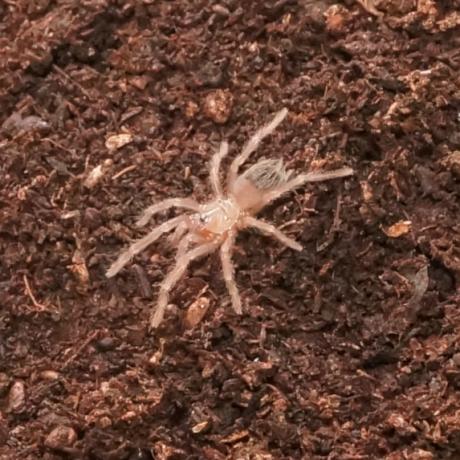

Rarely available as captive bred spiderlings, this tarantula is a must for any serious birdeater collection.
| Lifestyle | Terrestrial |
|---|---|
| Adult Size | Up to 16cm |
| Growth Rate | Moderate |
| Environment | Rainforest |
| Suitability | Beginner |
| Temperament | Docile |
One of the smaller representives of the genus. This docile and medium sized terrestrial tarantula can reach bodylengths of 8cm (around 16cm leg span).
Lasiodora difficilis have a black base colouration all over, with white to pink setae hair on their legs and a pale white fringe around the carapace. The firey red abdomen of long setae hair is their most distinctive feature
This species inhabits tropical rainforests in Brazil. Lasiodora difficilis was described way back in 1921 by Mello-Leitão. This Brazilian zoologist was considered the founder of Arachnology in South America.
Juveniles to adults can be kept in terrestrial style plastic tank or suitably sized glass enclosure. Spiderlings should be kept in plastic vials or deli containers until big enough to house into larger enclosures without them escaping.
Space heating is always the best method for heating tarantulas but a small heat mat will suffice at the side of the enclosure if required. Aim to maintain temperatures between 24-26ºC daytime, with a night-time drop to 20ºC. Maintain higher humidity (75-80%) compared to that of Lasiodora parahybana or Lasiodora klugi. To raise humidity, deliberately overflow the waterbowl and spray the enclosure more frequently. Allow a small area of the tank to dry out so the substrate doesn't become saturated. For spiderlings, keep the substrate in the vial slightly damp but not wet.
For substrate provide a minimum layer of 7-10cm of loose coir or peat for juvenules and adults. Coir can be purchased in compressed block form (which expands) or loose. Peat is available in loose bags only. As an alternative, there is also a selection of specialist invert substrates. For spiderlings half fill a vial with loose substrate as it will also allow them to burrow.
Provide a shelter for the tarantula to feel secure, this can be as simple as a coconut hide or a piece of curved cork bark for them to get under or behind. Don't be alarmed if your spider ignores the retreat and sits out in the open.
A basic water bowl for drinking is advisable for juvenile and adults. Tarantulas generally feed on a variety of suitably sized live food; including crickets, mealworms, cockroaches and locusts. Most species of tarantula for example, will eat no more than a couple of suitable sized crickets per week.